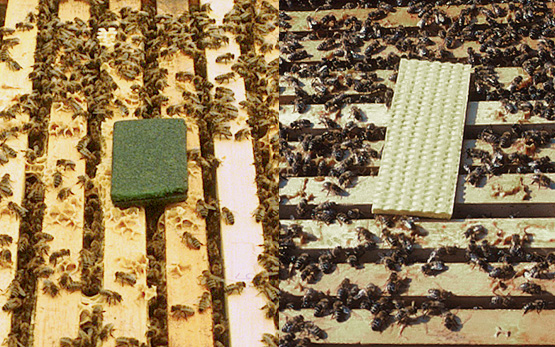Imdorf, A., Kilchenmann, V., Maquelin, C.
Optimale Ameisensäureanwendung.
Schweizerische Bienen-Zeitung, 113, (7), 1990, 378-385.
Imdorf, A., Bogdanov, S., Gerig, L., Kilchenmann, V.
Rückstände von Fluvalinate in Wachs, Futter, Honig, Pollen und Bienen nach längerfristiger Anwendung von Apistan.
Interner Bericht Sektion Bienen, (6), 1989, 1-5.
Kilchenmann, V., Imdorf, A.
Vergleich verschiedener Materialien als Platten für die Ameisensäurebehandlung.
Interner Bericht Sektion Bienen, (7), 1989, 1-4.
Imdorf, A., Kilchenmann, V., Maquelin, C.
Welchen Einfluss hat die Pollenfütterung im Frühjahr auf die Volksentwicklung ?
Schweizerische Bienen-Zeitung, 22, (4), 1988, 109-115.
Imdorf, A., Kilchenmann, V., Maquelin, C.
Quali sono gli effetti della nutrizione primaverile a base di polline, sullo sviluppo della colonia?
l'Ape, 71, (6,7), 1988, 92-94.
Imdorf, A., Kilchenmann, V., Maquelin, C.
Quelle est l'influence du nourrissement au pollen au printemps sur le développement des colonies ?
Journal Suisse d'apiculture, 85, (8), 1988, 67-76.
Imdorf A., Bühlmann G., Gerig L., Kilchenmann V., Wille H.
Überprüfung der Schätzmethode zur Ermittlung der Brutfläche und der Anzahl Arbeiterinnen in freifliegenden Bienenvölkern.
Apidologie, 18, (2), 1987, 137-146.
weitere Sprachen: englisch
Imdorf, A., Kilchenmann, V.
Le dévelopment des essaims artificiels et des colonies mères.
Journal Suisse d'apiculture, 84, (6), 1987, 209-216.
Wille, M., Wille, H., Imdorf, A., Kilchenmann, V.
Vergleichende Untersuchungen über den Stickstoff-/Proteingehalt von Pollensammelproben. Ergebnisse gewonnen anhand der botanischen Zusammensetzung und chemischen Analysen.
Interner Bericht Sektion Bienen, (2), 1987, 1-16.
Wille, H., Wille, M., Kilchenmann, V., Imdorf, A.
Die Pollenernährung des überwinternden und auswinternden Bienenvolkes.
Mitteilungen des Schweizerischen Zentrums für Bienenforschung, (2), 1987, 1-11.
Wille, H., Imdorf, A., Kilchenmann, V., Blank, F.
Wie wirken sich auffällige Störungen in der Pollenversorgung auf die Bruttätigkeit und Arbeiterinnenpopulationen aus. Beispiel Intragna (1978)-1983-1986.
Interner Bericht Sektion Bienen, (1), 1987, 1-16.
Wille, H., Imdorf, A., Kilchenmann, V.
Vereinfachtes Verfahren zur quantitativen Erfassung der Pollenversorgung der Bienenvölker.
Interner Bericht Sektion Bienen, (3), 1987, 1-13.
Imdorf, A., Kilchenmann, V., Walthert, A.., Ryf, H., Crelier, F., Sollberger, E.
Intergrierte Varroabekämpfung.
Schweizerische Bienen-Zeitung, (4), 1987, 143-153.
Imdorf, A., Bühlmann, G., Wille, H., Kilchenmann, V.
The nitrogen balance of free flying Apis mellifera colonies.
In: Chemistry and Biology of Social Insects, pp757, ed by Eder, J and Rembold, H , Verlag J Peperny, München, 1987, 169-0.
Imdorf, A., Kilchenmann, V.
Entwicklung von Kunstschwärmen und Muttervölkern.
Schweizerische Bienen-Zeitung, 110, (5), 1987, 189-202.
Wille, H., Imdorf, A., Bühlmann, G., Kilchenmann, V., Wille, M.
Beziehung zwischen Polleneintrag, Brutaufzucht und mittlerer Lebenserwartung der Arbeiterinnen in Bienenvölkern (Apis mellifera L.).
Bienenwelt, 28, 1986, 57-65.
Imdorf, A., Bogdanov, S., Kilchenmann, V.
Du miel de miellat cristallisé dans les hausses et les corps de ruche, comment réagir? 2e partie: b) Pourquoi le miel de miellat cristallisé est-il toxique pour les abeilles pendant l'hivernage?
Journal Suisse d'apiculture, 83, (6), 1986, 240-244.
Imdorf, A., Bogdanov, S., Kilchenmann, V.
Du miel de miellat cristallisé dans les hausses et les corps de ruche.. comment réagir? 1re partie: hivernage sur du miel de miellat cristallisé.
Journal Suisse d'apiculture, 82, (12), 1985, 438-446.
Imdorf, A., Kilchenmann, V.
Entwicklung von Ablegern und Muttervölkern.
Schweizerische Bienen-Zeitung, 108, (5), 1985, 212-225.
Imdorf, A., Bogdanov, S., Kilchenmann, V., Wille, H.
Zementhonig? im Honig- und Brutraum - was dann? 2. Teil: Wirkt "Zementhonig" als Winterfutter toxisch?
Schweizerische Bienen-Zeitung, 108, (11), 1985, 581-590.






